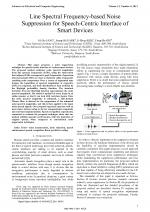| 4/2011 - 1 | View TOC | « Previous Article | Next Article » |
Line Spectral Frequency-based Noise Suppression for Speech-Centric Interface of Smart DevicesJANG, G. J. |
| Extra paper information in |
| Click to see author's profile in |
| Download PDF |
Author keywords
noise measurement, noise reduction, speech enhancement, speech recognition, linear predictive coding
References keywords
speech(15), spectral(6), processing(5), signal(4), recognition(4)
Blue keywords are present in both the references section and the paper title.
About this article
Date of Publication: 2011-11-30
Volume 11, Issue 4, Year 2011, On page(s): 3 - 8
ISSN: 1582-7445, e-ISSN: 1844-7600
Digital Object Identifier: 10.4316/AECE.2011.04001
Web of Science Accession Number: 000297764500001
SCOPUS ID: 84863083144
Abstract
This paper proposes a noise suppression technique for speech-centric interface of various smart devices. The proposed method estimates noise spectral magnitudes from line spectral frequencies (LSFs), using the observation that adjacent LSFs correspond to peak frequencies of spectrum, whereas isolated LSFs are close to flattened valley frequencies retaining noise components. Over a course of segmented time frames, the logarithms of spectral magnitudes at respective LSFs are computed, and their distribution is then modeled by the Rayleigh probability density function. The standard deviation from the Rayleigh function approximates the noise spectral magnitude. The model is updated at every frame in an online manner so that it can deal with real-time inputs. Once the noise spectral magnitude is estimated, a time-domain Wiener filter is derived for the suppression of the estimated noise spectral magnitude, and this is then applied to the input noisy speech signals. Our proposed approach operates well on most smart devices owing to its low computational complexity and real-time implementation. Speech recognition experiments, conducted to evaluate the proposed technique, show that our method exhibits superior performance, with less distortion of original speech, when compared to conventional noise suppression techniques. |
| References | | | Cited By |
Web of Science® Times Cited: 4 [View]
View record in Web of Science® [View]
View Related Records® [View]
Updated today
SCOPUS® Times Cited: 5
View record in SCOPUS® [Free preview]
View citations in SCOPUS® [Free preview]
[1] Particle filtering based pitch sequence correction for monaural speech segregation, Kim, Han‐Gyu, Jang, Gil‐Jin, Park, Jeong‐Sik, Kim, Ji‐Hwan, Oh, Yung‐Hwan, International Journal of Imaging Systems and Technology, ISSN 0899-9457, Issue 1, Volume 23, 2013.
Digital Object Identifier: 10.1002/ima.22039 [CrossRef]
[2] An improved multi-band spectral subtraction technique designed for cochlear implant users, Boucherit, Ismail, Amokrane, Zouhir, Mohamed, Ould Zmirli, Kebir, Sofiane Tchoketch, STUDIES IN ENGINEERING AND EXACT SCIENCES, ISSN 2764-0981, Issue 2, Volume 5, 2024.
Digital Object Identifier: 10.54021/seesv5n2-571 [CrossRef]
[3] Acoustic interference cancellation for a voice-driven interface in smart TVs, Park, Jeong-Sik, Jang, Gil-Jin, Kim, Ji-Hwan, Kim, Sang-Hoon, IEEE Transactions on Consumer Electronics, ISSN 0098-3063, Issue 1, Volume 59, 2013.
Digital Object Identifier: 10.1109/TCE.2013.6490266 [CrossRef]
[4] Unsupervised noise reduction scheme for voice-based information retrieval in mobile environments, Park, Jeong-Sik, Jang, Gil-Jin, Kim, Ji-Hwan, Yeo, Sang-Soo, Multimedia Tools and Applications, ISSN 1380-7501, Issue 9, Volume 75, 2016.
Digital Object Identifier: 10.1007/s11042-013-1788-y [CrossRef]
[5] Particle filtering by sigmoidal weight update for speech pitch correction, Kim, Han-Gyu, Park, Jeong-Sik, Jang, Gil-Jin, Oh, Yung-Hwan, 2012 IEEE International Conference on Systems, Man, and Cybernetics (SMC), ISBN 978-1-4673-1714-6, 2012.
Digital Object Identifier: 10.1109/ICSMC.2012.6378133 [CrossRef]
Disclaimer: All information displayed above was retrieved by using remote connections to respective databases. For the best user experience, we update all data by using background processes, and use caches in order to reduce the load on the servers we retrieve the information from. As we have no control on the availability of the database servers and sometimes the Internet connectivity may be affected, we do not guarantee the information is correct or complete. For the most accurate data, please always consult the database sites directly. Some external links require authentication or an institutional subscription.
Web of Science® is a registered trademark of Clarivate Analytics, Scopus® is a registered trademark of Elsevier B.V., other product names, company names, brand names, trademarks and logos are the property of their respective owners.
Faculty of Electrical Engineering and Computer Science
Stefan cel Mare University of Suceava, Romania
All rights reserved: Advances in Electrical and Computer Engineering is a registered trademark of the Stefan cel Mare University of Suceava. No part of this publication may be reproduced, stored in a retrieval system, photocopied, recorded or archived, without the written permission from the Editor. When authors submit their papers for publication, they agree that the copyright for their article be transferred to the Faculty of Electrical Engineering and Computer Science, Stefan cel Mare University of Suceava, Romania, if and only if the articles are accepted for publication. The copyright covers the exclusive rights to reproduce and distribute the article, including reprints and translations.
Permission for other use: The copyright owner's consent does not extend to copying for general distribution, for promotion, for creating new works, or for resale. Specific written permission must be obtained from the Editor for such copying. Direct linking to files hosted on this website is strictly prohibited.
Disclaimer: Whilst every effort is made by the publishers and editorial board to see that no inaccurate or misleading data, opinions or statements appear in this journal, they wish to make it clear that all information and opinions formulated in the articles, as well as linguistic accuracy, are the sole responsibility of the author.



